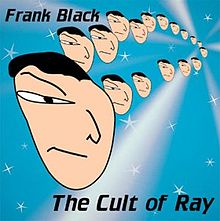 The Cult Of Ray – When The Cult Of Ray is abrasive, it is really abrasive, as on the first cut, “The Marsist.” However, it does not reject directions taken on the first two Frank Black albums. “I Don’t Want To Hurt You (Every Single Time)” is so “pop” that longtime fans have considered it the nadir of Black’s output. (I happen to like it, but what do I know?) In the middle are songs that consistently revisit familiar themes. “The Cult Of Ray” is dedicated to The Martian Chronicles author Ray Bradbury and “Men In Black” arrived several years before the Tommy Lee Jones and Will Smith film did. “Jesus Was Right” reminds us of Black’s flirtations with religious thought, if only tangentially.
The Cult Of Ray – When The Cult Of Ray is abrasive, it is really abrasive, as on the first cut, “The Marsist.” However, it does not reject directions taken on the first two Frank Black albums. “I Don’t Want To Hurt You (Every Single Time)” is so “pop” that longtime fans have considered it the nadir of Black’s output. (I happen to like it, but what do I know?) In the middle are songs that consistently revisit familiar themes. “The Cult Of Ray” is dedicated to The Martian Chronicles author Ray Bradbury and “Men In Black” arrived several years before the Tommy Lee Jones and Will Smith film did. “Jesus Was Right” reminds us of Black’s flirtations with religious thought, if only tangentially.
The more things stay familiar, the more they change. Black jumped the Elektra ship and wound up on Rick Rubin’s American imprint. Eric Drew Feldman was gone from the group and from the producer’s chair (but was credited in the Thank-Yous of the record). Black helmed this one solo, adopting a “live band” ethic in the process. His backing band, though not credited as such at this point, would become “The Catholics,” a foil for Black’s musical endeavors for many years to follow. Feldman returned as a player on the record Dog In The Sand a few years later and would stay in Black’s orbit frequently thereafter.
Another thing that changed was the art direction duties for packaging the albums. Having previously been under the auspices of the 4AD label, in relationship with Elektra, Black lost the services of graphic designer Simon Larbalestier/v23 and others under that umbrella. The cover of The Cult Of Ray may well have been designed in Microsoft Paint. It’s lack of style and production value might have been a perverse rejection of the trappings of his former label situation. It might just be a reflection of going on-the-cheap and DIY. It might just be a steaming bowl of “I don’t give a f***.” I have no answers to that question.
The album has grown on me over time, I must say. The first time I heard it, I suppose I had the same responses so many did — confusion, bewilderment, lack of enthusiasm. Black wasn’t phoning it in, that was certain.
In another strange turn, the album ends with what could be described as Black’s own “Biko,” at least if you knew the backstory. Coming off an album with so much sci-fi code in the way, one could be forgiven for thinking Shazeb Andleeb was a character. However, he was a real person, a 17-year-old, 11th grade student of Pakistani descent who was murdered in the halls of his high school in 1995. Words were said to him, apparently, by another student in the hallway. He said something back. That person and, according to reports, nine others punched and stomped him repeatedly, crushing Andleeb’s adam’s apple. He died from asphyxiation, complicated by the severity of the brutal attack.
To take in the presence of Frank Black is perhaps to understand why he chose to write and record the song. He is a hefty man. He has long expressed an interest in sci-fi. He was raised by his mom and stepfather who belonged to the evangelical Assemblies of God church. Apart from his having a stepfather, Charles Thompson could be me, and surely must know what it is like to be an outsider even in the smallest of groups. He very well could have suffered in school due to his differences. He may have done terribly with girls, which could have instigated all manner of social disorders. He might have been knocked around not for what he did, but just because he was. He wasn’t Pakistani (and to my knowledge, neither am I!) but he understands the dark side of not being in the majority. In that context, “The Last Stand of Shazeb Andleeb” might not be such a weird addition to the Frank Black catalog after all…but this is all wild speculation.
The Cult Of Ray is not a bad record, but it suffers the same fate as the first solo record did, which is this: listeners who had a preconceived idea of what Black Francis product should sound like were not prepared for Frank Black. So too, listeners who appreciated that Frank Black were less amenable to this Frank Black. The key would have to be allowing it to grow on you, and to accept songs that were more conventional than before. Not bad, just more conventional.
 Why Should We Care About Staffing? – Probably the most prominent challenge to the current information and mishegas around the Pixies’ reunion, or even to how the band had carried on throughout the years, is that those who have worked and continue to work with Francis/Black/Thompson are quite loyal, and are rather protective, including the remaining members of Pixies. Joey Santiago has been Black’s sidearm roughly the entire career. Something here is working, clearly.
Why Should We Care About Staffing? – Probably the most prominent challenge to the current information and mishegas around the Pixies’ reunion, or even to how the band had carried on throughout the years, is that those who have worked and continue to work with Francis/Black/Thompson are quite loyal, and are rather protective, including the remaining members of Pixies. Joey Santiago has been Black’s sidearm roughly the entire career. Something here is working, clearly.
Black often recruited talented people for their talent, but kept them in his company because they were friends, they understood each other, and worked together well. In short, it is important to view anything that is apart from the new Pixies music itself through both sides of the situation. Perhaps worrying about anything but the music itself is only wasted energy to begin with.
“‘This professional relationship’ — hmmm…..that sounds strange to me,” said Feldman when I posed the question. “I’m pretty comfortable around Charles. In being in close quarters with someone in a recording studio, a bus or a van, one tries not to get on anyone’s nerves the best he can. Charles has always been generous and treated me with respect. I will always try to return the favor.”
Next time – Mr. Black Gets Religion: Frank Black enters a period of prodigious output and on one of those initial albums justifies every move he made up to that point.
Special thanks to Peter Lubin and Eric Drew Feldman for their input in this article.





Comments